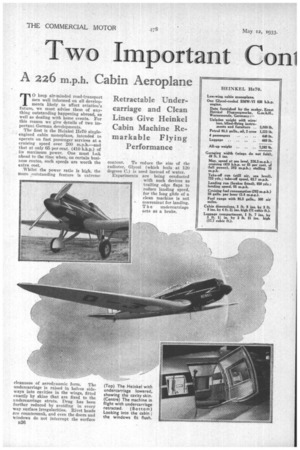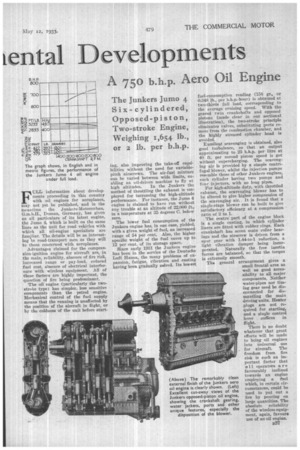Two Import nt Coni tental evelopments
Page 54

Page 55

If you've noticed an error in this article please click here to report it so we can fix it.
T0 keep air-minded road-transport Men well informed on all developments likely to affect aviation's future, we must advise them of anything outstanding happening abroad, as well as dealing with home events. For this reason we give details of two important German developments.
The first is the Heinkel 11e70 singleengined cabin monoplane, intended to operate on fast passenger services at a cruising speed over 200 m.p.h.—and that at only 65 per cent. (410 b.h.p.) of its maximum power. One must look ahead to the time when, on certain business routes, such speeds are worth the extra cost.
Whilst tha power ratio is high, the more _outstanding feature is extreme cleanness of aerodynamic form. The undercarriage is raised in halves sideways into cavities in the wings, fitted exactly by skins that are fixed to the undercarriage struts. Drag has been further reduced by avoiding in every way surface irregularities. Rivet heads are countersunk, and even the doors and windows do not interrupt the surface B38
FULL information about develop. ments proceeding in this country with oil engines for aeroplanes, may not yet be published, and in the meantime the Junke rs-llo toren ban, G.m.b.H., Dessau, Germany, has given us all particulars of its latest engine, the Juin° 4, which is built on the same lines as the unit for road vehicles with which all oil-engine specialists are familiar. The details will be as interesting `to road-transport men as they will to those concerned with aeroplanes.
Advantages claimed for the compression-ignition engine for aircraft are, in the main, reliability, absence of fire risk, increased range or pay-load, reduced fuel cost, absence of electrical interference with wireless equipment. All of these factors are highly important, the question of fire being predominant.
The oil engine (particularly the twostroke type) has simpler, less sensitive components than the petrol engine. Mechanical control of the fuel supply means that the running is unaffected by the position of the aircraft in flight, or by the coldness of the unit before start
jug, also improving the take-off cap& bilities without the need for variablepitch au-screws. The air-fuel mixture can be varied between wide limits, enabling an oil-driven machine to fly at
high altitudes. In the Junkers the method of throttling the exhaust is employed for increasing the high-altitude performance. For instance, the Jumo 4 engine is claimed to have run without any trouble at an altitude of 22,000 ft., in a temperature at 35 degrees C. below zero.
The lower fuel consumption of the Junkers engine has, in one case, yielded, with a given weight of fuel, an increased range of 34 per cent. .Also, the higher specific weight of the fuel saves up to 12 per cent, of its storage space.
Since early 1931 the Junkers engine has been in the 'service a the Deutsche Luft Hansa, the many problems of expansion, fatigue, vibration and casting having been gradually solved. Its lowest
fuel-consumption reading (158 gr., or 0.348 lb., per b.h.p.-hour) is obtained at two-thirds full load, corresponding to the average cruising speed. With the geared twin crankshafts and opposed pistons (made clear in our sectional illustration), the two-stroke principle eliminates valves, substituting ports remote from the combustion chamber, and the highly stressed cylinder head is avoided.
Excellent scavenging is obtained, also good turbulence, so that an Output approximating to 25 b.h.p per litre at 40 ft. per second piston speed is got without supercharging. The scavenging air is provided by a simple centrifugal blower, whilst the injection pumps resemble those of other Junkers engines, each cylinder having two pumps and four injectors, with no long pipes.
For high-altitude duty, with throttled exhaust, the scavenging blower has to be altered to give higher compression of the scavenging air. It is found that a single-stage blower can be built to give satisfactory efficiency at a compression ratio of 2 to I.
The centre part of the engine block is a single casting, in which cylinder liners are fitted with rubber rings. Each crankshaft has seven main roller bearings and the airserew is driven from a spur gear with 1.44-to-1 reduction, a light vibration damper being incorporated. Naturally the free inertia forces are balanced, so that the torque is extremely smooth.
The general arrangement gives a small frontal area as well as good accessibility to all major components. Neither water-pipes nor timing gear need be disconnected for dismantling the main driving units. Heater plugs are not required for starting, and a single control lever suffices in flight.
There is no doubt whatever that great efforts will be made to bring oil engines into universal use for aircraft. The freedom from fire risk is such an important factor that all operators are favourably inclined towards an engine employing a fuel which, in certain circumstances, could be used to put out a fire by pouring on large quantities. The absolute reliability of the wireless equipment, again, favours use of an oil engine.




































































































